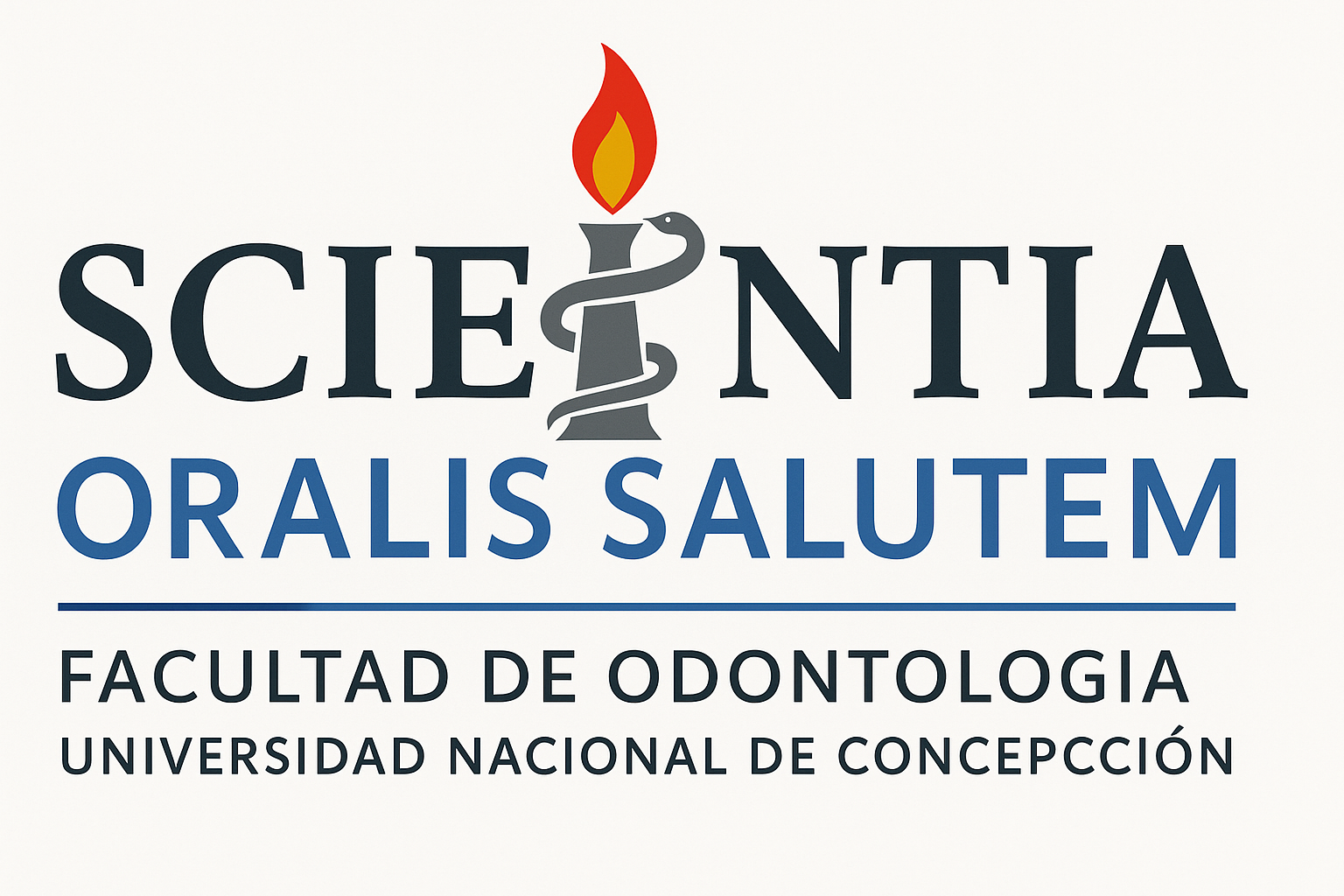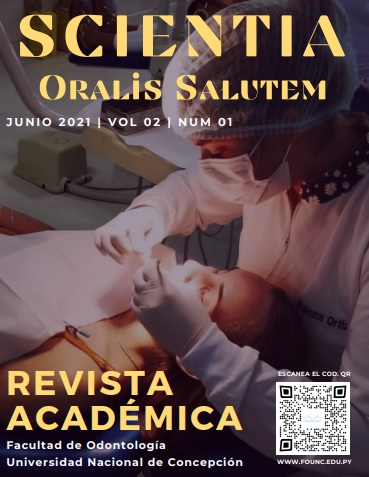Efectividad de la Irrigación Pasiva Ultrasónica (PUI) según la literatura científica en los últimos 10 años
Effectiveness of Passive Ultrasonic Irrigation (PUI) according to the scientific literature in the last 10 years
Palabras clave:
efectividad, PUI, smear layer, bacterias, IrrisafeResumen
La clave del éxito de la terapia endodóntica es la limpieza y desinfección del sistema de conductos radiculares. Objetivo: determinar la efectividad de la técnica de irrigación pasiva ultrasónica en la eliminación del smear layer, la permeabilidad de los túbulos dentinarios y mayor eliminación de bacterias plactonicas en combinación con soluciones irrigantes. Metodología: la investigación se enmarcó dentro del tipo de análisis de artículos científicos referente a PUI es decir Irrigación pasiva ultrasónica. Resultados: Los datos fueron analizados y originados en gráficos estadísticos demostrando así que (PUI) es más efectiva que la irrigación manual o convencional ya que ha demostrado ser más eficaz en la eliminación de smear layer, bacterias plactonicas, tejido pulpar y restos de desechos producidos por la instrumentación del conducto radicular en todos sus tercios. Abarca lugares del conducto radicular donde la irrigacion manual no logra alcanzar y además ha optimizado la permeabilidad de los túbulos dentinarios. Conclusión: El sistema Irrisafe ha sido mencionado como el sistema más utilizado en los últimos tiempos. La solución más utilizada es el hipoclorito de sodio por demostrar ser superior a las demás soluciones irrigantes
Referencias
Dalai DR, Bhaskar DJ, R CA, Singh N, Singh H. Modern Concepts of Ultrasonic Root Canal Irrigation. Int J Adv Heal Sci [Internet]. 2014;1(4):2–5. Available from: http://www.ijahs.net/uploads/2/6/7/7/26772457/ijahs_vol_1_issue_4_1.pdf
Ahmed Alkahtani TDAK and SA. A comparative study of the debridement efficacy and apical extrusion of dynamic and passive root canal irrigation systems. In: Informatics in Primary Care [Internet]. 2012. p. 77–9. Available from: https://bmcoralhealth.biomedcentral.com/articles/10.1186/1472-6831-14-12#Sec11
Joy J, Mathias J, Sagir VMM, Babu BP, Chirayath KJ, Hameed H. Bacterial Biofilm Removal Using Static and Passive Ultrasonic Irrigation. J Int oral Heal JIOH [Internet]. 2015;7(7):42–7. Available from: http://www.ncbi.nlm.nih.gov/pubmed/26229369
Mozo S, Llena C, Forner L. Review of ultrasonic irrigation in endodontics: Increasing action of irrigating solutions. 2012;17(3):1–6. Available from: http://pubmedcentralcanada.ca/pmcc/articles/PMC3476090/
Mozo S, Llena C, Chieffi N, Forner L, Ferrari M. Effectiveness of passive ultrasonic irrigation in improving elimination of smear layer and opening tubules. J Clin Exp Dent [Internet]. 2014;6(1):1–6. Available from: http://www.ncbi.nlm.nih.gov/pmc/articles/PMC3935905/
Prichard AJ. The effect of ultrasonic irrigation variables on the dimensions of artificial root canals.pdf [Internet]. Vol. 1. endopraticeus.com; 2012. p. 6. Available from: http://www.dental-tribune.com/printarchive/download/document/23086/file/672d0d79804129243c82417b2774a40e_14-17.pdf
Llena C, Cuesta C, Forner L, Mozo S, Segura J. The effect of passive ultrasonic activation of 2% chlorhexidine or 3% sodium hypochlorite in canal wall cleaning. J Clin Exp Dent [Internet]. 2015;7(1):e69–73. Available from: http://www.medicinaoral.com/odo/volumenes/v7i1/jcedv7i1p69.pdf
Merino A, Estevez R, de Gregorio C, Cohenca N. The effect of different taper preparations on the ability of sonic and passive ultrasonic irrigation to reach the working length in curved canals. Int Endod J [Internet]. 2013;46(5):427–33. Available from: http://abacus.universidadeuropea.es/handle/11268/2178
Dalai, D. R., Bhaskar, D. J., Agali, C. R., Singh, N., & Singh, H. (2014). Modern concepts of ultrasonic root canal irrigation. Int J Adv Health Sci, 1(4), 1-4. http://citeseerx.ist.psu.edu/viewdoc/download?doi=10.1.1.682.9966&rep=rep1&type=pdf
Srirekha A, Rashmi K, Hegde J, Lekha S, Rupali K, Reshmi G. An in vitro evaluation of passive ultrasonic agitation of different irrigants on smear layer removal after post space preparation: A scanning electron microscopic study. J Indian Prosthodont Soc [Internet]. 2013;13(3):240–6. Available from: http://www.ncbi.nlm.nih.gov/pubmed/24431741
Llena C, Forner L, Cambralla R, Lozano A. Effect of three different irrigation solutions applied by passive ultrasonic irrigation. Restor Dent Endod [Internet]. 2015;40(2):143–8. Available from: http://www.pubmedcentral.nih.gov/articlerender.fcgi?artid=4432257&tool=pmcentrez&rendertype=abstract
Latheef AA, Miglani R, , Rajamani Indira , Mohammed Abdul Kader , Vahid Shakeela Nasim SVS. Effect of Passive Ultrasonic Irrigation on the Cleanliness of Dentinal Tubules in Non-surgical Endodontic Retreatment with and without Solvent : A Scanning Electron Microscope Study. J Int Oral Heal [Internet]. 2016;8(February):753–9. Available from: http://www.ispcd.org/userfiles/rishabh/V8I7/V8I7A2.pdf
Vinhorte, M. C., Suzuki, E. H., de Carvalho, M. S., Marques, A. A. F., Júnior, E. C. S., & Garcia, L. D. F. R. (2014). Effect of passive ultrasonic agitation during final irrigation on cleaning capacity of hybrid instrumentation. Restorative dentistry & endodontics, 39(2), 104. https://europepmc.org/article/PMC/3978099
T. Rodig, M. Sedghi, F. Konietschke, K. Lange DZ y MH. Efficacy of syringe irrigation, RinsEndo and passive ultrasonic irrigation in removing debris from irregularities in root canals with different apical sizes. Int Endod J [Internet]. 2010;43(7):581–9. Available from: http://www.ncbi.nlm.nih.gov/pubmed/20636517
G. AMZA, Dr. Eng. O. Elena AMZA DEZA. Ultrasonic treatment endodontice [Internet]. 2010. p. 1–11. Available from: http://www.utgjiu.ro/rev_mec/mecanica/pdf/2010-02/12_Amza Gheorghe.pdf
Zahed Mohammadi, a, b Sousan Shalavi, c Luciano Giardino, d Flavio Palazzi e and SA. Impact of Ultrasonic Activation on the Effectiveness of Sodium Hypochlorite: A Review [Internet]. 2015. p. 1–6. Available from: http://www.ncbi.nlm.nih.gov/pmc/articles/PMC4609656/
Nf N, Sid R, Ghodbane N. Contribution of the passive ultrasonic irrigation “ PUI ” and LASER Nd : YAP in the reduction of endodontic bacterial flora . Curr Pediatr Res [Internet]. 2016;20(1):227–30. Available from: http://eds.b.ebscohost.com/eds/pdfviewer/pdfviewer?vid=29&sid=3ded0c8a-2324-4e1e-9a84-41e874a2f00a%40sessionmgr120&hid=119
Descargas
Publicado
Número
Sección
Licencia
Derechos de autor 2021 Fátima Natalia González Rodríguez

Esta obra está bajo una licencia internacional Creative Commons Atribución-NoComercial 4.0.


